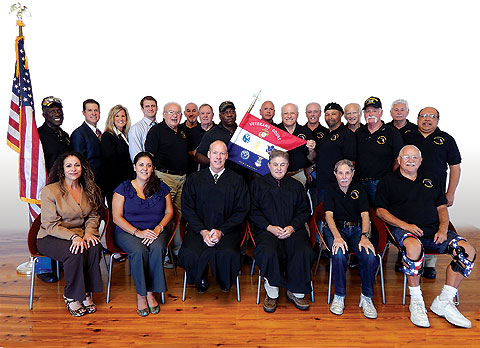 |
||||||||||||
|
July/August 2016
BY WILLIAM C. TRIPLETT The success of veterans treatment courts is so compelling that Jerry Klein, a member of West Palm Beach, Fla., Chapter 25 and a past president of VVA’s Florida State Council, has a hard time understanding why there aren’t more across the country. Of the more than 3,400 local jurisdictions in the U.S., only about 220 have one. Then again, Klein played a key role in establishing the veterans court in Palm Beach County, and he realizes the process isn’t easy. “Unless you get everybody on board who needs to be on board,” he said, “it’s not going to happen.” And a lot of people need to get on board. Scott DeArman knows this all too well. A longtime VVA member, DeArman has been trying for the last three years to set up a veterans treatment court in Arizona’s Yavapai County. Unfortunately, “there are entities within the local government which do not support” the idea, he said. But he’s still trying. Call it a tale of two counties with differing views on veterans treatment courts. Those views can be summed up in a way that has a particular resonance for Vietnam veterans: When it comes to veterans issues, some people’s hearts and minds still need changing. As readers of The VVA Veteran may remember from previous articles, veterans treatment courts are patterned on drug treatment courts. People who commit usually non-violent crimes that are in some way tied to drug or alcohol abuse or mental health problems can avoid jail and a criminal record if they commit to court-ordered treatment or therapy. Whether the program they enter runs a few weeks, months, or longer, defendants must complete it and report their progress to the court along the way. One slip-up and the defendant can wind up in regular court facing sentencing and a record. According to the National Association of Drug Court Professionals, drug treatment courts have been highly successful in getting people clean, reducing drug- and alcohol-related crime, and saving public money. “Nationwide, for every dollar invested in Drug Courts, taxpayers save as much as $3.36 in avoided criminal justice costs alone,” NADCP reports. The first veterans treatment court was established in 2008 in Buffalo, N.Y., after Judge Robert Russell, who presided over a drug treatment court, noticed two things: an increasing number of veterans appearing in the docket, and—perhaps most important—the positive way defendants who were veterans accepted help or advice from other veterans. Two simultaneous wars were producing thousands of discharged men and women with symptoms of post-traumatic stress disorder—nearly 20 percent of all who had deployed to Iraq and Afghanistan, according to a Rand Corp. study—or some degree of traumatic brain injury, or both. As a result, many of these veterans also suffered from drug or alcohol abuse and mental health issues, which provoked behavior that landed them in court.
What caught Russell’s attention was one veteran’s sudden jump in motivation to change his life after speaking just briefly with Jack O’Connor, a veterans legal advocate and member of Western New York Chapter 77 who often consulted at Russell’s court. O’Connor encouraged the veteran to get involved with his own healing, saying that a lot of other veterans would be helping him along the way. The veteran-to-veteran bond, particularly among those who’ve taken part in a war, proved uniquely positive. Not only did this veteran turn his life around, but shortly after Russell established a veterans treatment court, it experienced a 90 percent success rate among veterans who committed to a program. Recidivism rate: zero percent. Klein first heard about Russell’s court from a fellow dedicated activist on veterans issues, Patrick Welch of Chapter 77 in Buffalo. Klein started talking with David Knapp, the president of Chapter 25, and to Roy Foster, who runs a program for homeless veterans, about setting up a veterans treatment court in Palm Beach County. With about 1.6 million veterans living in Florida—the third highest veteran population by state—Palm Beach County has its share of veterans needing help. Talk soon turned to action after Russell and O’Connor, at Welch’s invitation, attended VVA’s National Leadership Conference in 2010 in Orlando. Russell and O’Connor gave a presentation on the Buffalo court and its successes. Afterward, Klein met with the judge and advocate and asked if they could share information or training materials that would help establish a veterans court in Palm Beach County. “Within days I had all of their training material,” Klein said. The material focused on the important role that mentors play in a veterans court. Mentors aren’t court officials, but volunteers, veterans themselves who attend a case involving a veteran. Mentors advise and help veterans when they enter therapy or counseling, helping them not only to complete the treatment program but also to get their lives back together. As Klein was digesting the training material, he and others also were trying to line up all the entities that would have to approve establishment of a veterans treatment court. The Florida Department of Corrections, then Palm Beach County Commission, the Sheriff’s Office, the West Palm Beach VA Medical Center, the county attorney and probation authorities—and more—would all have to sign on. One key official was Peter Blanc, then the chief judge of Palm Beach County. Approached with the idea of a veterans treatment court, Blanc turned to a colleague on the bench, Ted Booras, a Marine Corps veteran. “I thought it was an outstanding idea, long overdue,” Booras said. Booras presided at the Palm Beach County jail at the time and had been trying to figure out a way to help the many veterans who’d been appearing before him for typically petty crimes. Blanc issued the judicial order that created the Palm Beach County veterans treatment court, and Booras became presiding judge. Blanc also looked to two organizations to spearhead a mentors program: Chapter 25 and Roy Foster’s nonprofit that helps homeless veterans, Faith, Love, Hope and Charity. Klein designed the program based on the Buffalo model but with some tweaks. “Their training period for mentors is a week long; ours is less,” he said. “We’ve since produced a seven-part CD that provides all the training for our mentors,” Klein added. “We also do face-to-face training because we want to get to know the individuals. They have to fill out an application and be interviewed because we want to make sure we’ve got the right people. Being a veteran is required, and we now have all generations as mentors, Korean War generation to the current generation, male and female.”
Another unique feature of the Palm Beach County veterans court is a sort of built-in outreach mechanism. A psychologist and veteran of both Iraq and Afghanistan working at the local Vet Center came up with a program to inform every street-patrol law enforcement officer in the county what the veterans court is about. A similar program exists to acquaint and instruct members of the judiciary and bar association so that attorneys are aware of the veterans treatment court as an option. “It’s all been well thought out,” Klein said. “If the injured party agrees to veterans court, if the state’s attorney agrees, then that person will have the option of ending up in veterans court. But if the judicial and the legal systems didn’t know about the court, they wouldn’t have that option.” The Palm Beach County veterans court has helped two hundred veterans change their lives by completing court-ordered therapy and counseling programs. Klein said only ten became repeat offenders. Moreover, statistics show a savings of $2 million in taxpayer funds. “It costs money to keep people in jail,” Klein noted. The court has been so successful that other Florida counties have started establishing veterans treatment courts as well, many seeking Klein’s help and advice on how to do it. Because of the court’s success, VVA led an initiative that resulted in the Florida legislature mandating veterans courts in jurisdictions throughout the state. Looking back, Klein said the effort to create a veterans court never really hit any serious opposition. The military service of some of the important authorities involved undoubtedly helped. In addition to Booras being a former Marine, the state’s attorney is retired from the U.S. Air Force, and the public defender was with the 9th Infantry Division in Vietnam. “They all get it,” Klein said. “That’s the key.” But non-veterans should be able to get it, too, he believes. “You look at the success rate, you look at the lives saved and the people not being incarcerated. How do you not implement such a program?” The answer appears to depend significantly on personal and political views, which vary from region to region. At least one logistical matter could impede creation of more veterans courts. Not all counties have a VA Medical Center, which provides the counseling and therapy. As Booras says, “That raises the question of who’s going to pay for counseling and therapy.” And taxpayer-funded budgets are tight everywhere. But that’s not a question that arises in Yavapai County, which is home to the Northern Arizona VA Health Care System in Prescott along with satellite clinics. DeArman says that opposition revolves around the belief that there’s no need for a veterans court. Part of that belief may be simply the result of not having enough information. DeArman once worked for the county sheriff’s office as a behavioral therapist in the jail. He met plenty of veterans inside who were struggling with mental health issues that clearly were factors in the crimes that had gotten them arrested. But there was no reliable official tally of the number of veterans moving through the system, despite the fact that everyone brought to the jail fills out an intake form containing the question, “Are you a veteran?” “A lot of them won’t check ‘yes’ on that,” DeArman said. “There’s still a stigma about being a veteran for a lot of guys.” Still, veterans are clearly there: The Arizona State Department of Veterans Services notes that there are some 600,000 living in the state, and not just retirees. “We have a flight school out here, and a lot of Iraq and Afghanistan vets are here trying to learn how to fly,” DeArman said. Klein has provided DeArman with a substantial amount of information demonstrating the success of the Palm Beach County veterans court. DeArman has passed all of it to county authorities. He hopes those still opposed will see both the financial savings veterans courts can yield and the very real human benefits—lives restored, often whole families since many veterans are married with children. “You’re not just saving one life, but many others,” DeArman said. There’s also a resistance to what some see as creating a special class or interest should veterans get their own treatment court. DeArman thinks the resistance is unfounded. “If you look at the criteria that’s mandated in a specialty court, there are higher requirements than for someone who just takes a plea bargain and moves on,” he said. “Until they complete every phase of the program, whatever it is, and pay restitution and do all they have to do, they don’t go free.” Booras added: “They’re only getting special treatment in that we’re getting them into the VA for help. Well, they’ve earned those benefits anyway, haven’t they?” DeArman remains optimistic that at some point enough of the needed hearts and minds will change, and a veterans treatment court will appear in Yavapai County. “But until then,” he said, “we’re sacrificing veterans.”
|
||||||||||||
|
|
||||||||||||
|
||||||||||||
8719 Colesville Road, Suite 100, Silver Spring. MD 20910 | www.vva.org | contact us |
||||||||||||






















